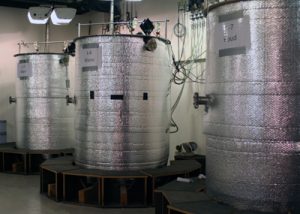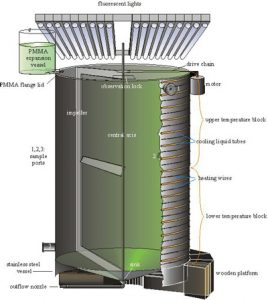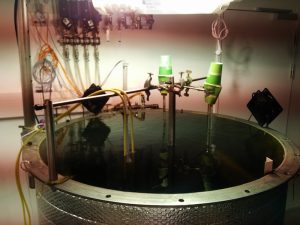Netherlands Institute for Ecology (NIOO)
Droevendaalsesteeg 10
6708 PB Wageningen
L.N. de Senerpont Domis
Please login or request access to view contact information.
indoor/outdoor – pelagic – freshwater
Limnotrons, outdoor enclosure facility, 36 experimental ponds
The limnotrons are 9 stainless steel indoor mesocosms with a high level of control. The dimensions of these vessels are: 0.97 m in diameter, a depth between 1.32 m (side) and 1.37 m (centre), and a volume of 922 L. The vessels can be closed with a removable PMMA flange lid. In addition to the possibility to sample vertically with specifically designed integrated water samples, sampling can also be done by using the sampling ports positioned on three depths. If needed, mixing of the water column can take place by an impeller made of
PMMA, with a stainless steel axis, and a silicon rubber strip between the outside and the Limnotron wall to prevent wall growth. To create a different type of mixing more tailored to growth of cyanobacterial scums, oscillating grids have been designed. Originally designed to study pelagic communities, the Limnotrons have been adapted to allow for a benthic community as well. At present, each Limnotron can have a sediment layer of 10-15 cm, and with the recently purchased high intensity lights, a macrophyte community can be established in these mesocosms.
A unique feature of the limnotrons is the temperature regulation with separate upper and lower temperature blocks to allow for thermal stratification. A thermostatically regulated microprocessor-controlled cooling and heating installation controls the temperature of each of the vessels individually at 0.1 oC SE. The temperature program allows for running complicated temperature scenarios, including episodic events. Temperature is logged every minute. Because of possible volume differences due to temperature settings, evaporation losses and sampling, a (refillable) expansion vessel was developed, which maintains a constant water volume in the experimental vessel. In addition, CO2 levels can be manipulated as well, by providing different CO2 /air mixtures with a WITT KM60-2ME gas mixer.
Temperature, Light, Mixing regime, CO2
The Limnotrons can be used to test the effect of warming, eutrophication and CO2 elevation on carbon cycling, stoichiometry of different trophic groups, nutrient balances, metabolism, adaptation and microevolution and community structure of phytoplankton, zooplankton, macrofauna, periphyton and macrophytes.
Advanced analytical equipment, including a number of flow cytometers (e.g. flowcytometry, Cytobuoy, FlowCam, IRMS, molecular lab), which use laser technology to identify, count, and sort algae, bacteria, and protozoa at high speed.
- Fluorescence microscopy
- Autoananalyzer for dissolved nutrients
- Multichannel probes for simultaneous measurements of oxygen, light, pH, conductivity and temperature
- Phytopam fluorometer
- Coulter particle counter
- Flowcytometer for analysis of phyto- and bacterioplankton (<90 micron)
- FLOWcam for automated analysis of larger celled phyto- and zooplankton
- Elemental analyser to measure particulate C and N
- IRMS to to measure the relative abundance of isotopes
- ICP-MS for detecting trace elements
- LC-MS/MS for detecting e.g. cyanotoxins
- GC-MS/MS for detecting volatiles
State-of the art molecular lab
No inhouse lodging available


 |
